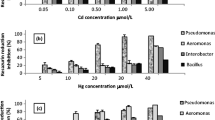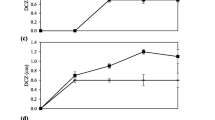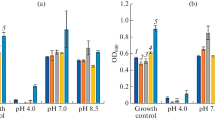Abstract
This study compared the tolerance limits of selected bacterial (Bacillus licheniformis, Brevibacillus lactosporus and Pseudomonas putida) and protozoan (Aspidisca, Trachelophyllum and Peranema) species to V5+ in wastewater systems. The isolates were exposed to various concentrations of V5+ (from 10 to 240 ppm), and their tolerance limits to this heavy metal were assessed at different temperatures (25, 30, 35 and 40°C) and pHs (4, 6, 7, 8 and 10) for 5 days. Chemical oxygen demand (COD), dissolved oxygen (DO) and die-off rate of the isolates were measured using standard methods. The results indicated that test isolates were tolerant to V5+, with a gradual decrease in their colony/cell counts when V5+ concentration gradually increased. Bacterial species were found to be more significantly tolerant (MIC: 110–230 ppm V5+) to V5+ than protozoan species which showed an earlier total inhibition/die-off rate (100%) at 60–100 ppm V5+ (MIC) (p < 0.001). P. putida was the most tolerant bacterial species (MIC: 230 ppm V5+) and Aspidisca sp. the most sensitive protozoan species (MIC: 60 ppm V5+). An increase in COD and DO removal was observed throughout the experimental period. The highest COD increase (up to 237.11%) and DO removal (almost 100%) were observed in mixed liquor inoculated with P. putida after exposure to 10 ppm V5+. Changes in pH and temperature affected the tolerance limits of all isolates. This study suggests the use of these tolerant bacterial and protozoan species in the bioremediation of V5+ from domestic and industrial wastewater under the control of pH and temperature.



Similar content being viewed by others
References
Abraham, J. V., Butler, R. D., & Sigee, D. C. (1997). Ciliate populations and metals in an activated-sludge plant. Water Res., 31(5), 1103–1111.
Akpor, O. B., Momba, M. N. B., & Okonkwo, J. O. (2008). The effects of pH and temperature on phosphate and nitrate uptake by wastewater protozoa. AJB, 7(13), 2221–2226.
Alluri, H. K., Ronda, S. R., Settalluri, V. S., Bondili, J. S., Suryanarayana, V., & Venkateshwar, P. (2007). Biosorption: an eco-friendly alternative for heavy metal removal. AJB, 6(25), 2924–2931.
Antipov, A. N., Lyalikova, N. N., & L’vov, N. P. (2000). Vanadium-binding protein excreted by vanadate-reducing bacteria. IUBMB Life, 49, 137–141.
Arican, B., & Yetis, U. (2003). Nickel sorption by acclimatized activated sludge culture. Water Res., 37(14), 3508–3516.
ATSDR, 2009. Toxicological profile for vanadium and compounds. Agency for Toxic Substances and Disease Registry, Atlanta, GA. US Department of Health and Human Services, Public Health Service.
Avery, S. V. (2001). Metal toxicity in yeast and the role of axidative stress. Adv Appl Microbiol, 49, 111–142.
Bell, J. M. L., Philp, J. C., Kuyukina, M. S., Ivshina, I. B., Dundar, S. A., Cunningham, C. J., & Anderson, P. (2004). Methods evaluating vanadium tolerance in bacteria isolates from crude oil contaminated land. J Microbiol Methods, 58, 87–100.
Bitton, G. (1999). Wastewater microbiology (2nd ed.). New York: Wiley-Liss.
Briand, L., Thomas, H., & Donati, E. (1996). Vanadium (V) reduction in Thiobacillus thiooxidans cultures on elemental sulfur. Biotechnol. lett., 18(5), 505–508.
Burton, G. A., Gunnison, D., & Lanza, G. R. (1987). Survival of pathogenic bacteria in various fresh water sediments. Appl. Environ. Microbiol., 53(4), 633–638.
Canovas, D., Cases, I., & de Lorenzo, V. (2003). Heavy metal tolerance and metal homeostasis in Pseudomonas putida as revealed by complete genome analysis. Environ Microbiol, 5(12), 1242–1256.
Chandy, C. P. (1999). Heavy metal tolerance in chromogenic and non-chromogenic marine bacteria from Arabian gulf. Environ Monit Assess, 59(3), 321–330.
Cheremisinoff, P. N. (1995). Handbook of water and wastewater treatment technology. New York: Marcel Dekker.
Choopan, A., Nakbud, K., Dawveerakul, K., Chawawisit, K., & Lertcanawanichakul, M. (2008). Anti-methicillin resistant Staphylococcus aureus activity of Brevibacillus laterosporus strain SA14. Walailak J. Sci Tech., 5(1), 47–56.
Clausen, C. A. (2000). Isolating metal-tolerant bacteria capable of removing copper, chromium, and arsenic from treated wood. Waste Manag Res, 18(3), 264–268.
Evangelou, A. M. (2002). Vanadium in cancer treatment. Crit Rev Oncol Hematol, 42, 249–265.
Emptage, C. D., Knox, R. J., Danson, M. J., & Hough, D. W. (2009). Nitroreductase from bacillus licheniformis: a stable enzyme for prodrug activation. Biochem. Pharmacol., 77, 21–29.
Ezzouhri, L., Castro, E., Moya, M., Espinola, F., & Lairini, K. (2009). Heavy metal tolerance of filamentous fungi isolated from polluted sites in Tangier, Morocco. AJMR, 3(2), 035–048.
Fonseca, P., Moreno, R., & Rojo, F. (2011). Growth of Pseudomonas putida at low temperature: global transcriptomic and proteomic analyses. Environ Microbiol Rep, 3(3), 329–339.
United Nations-Food and Agriculture Organisation (UN-FAO), 1985. Water quality for agriculture. Ayers ORS, Westcot DW. FAO Irrigation and Drainage Paper 29 (rev 1), FAO, Rome, p. 174.
Fukuda, N., & Yamase, T. (1997). In vitro antibacterial activity of vanadate and vanadyl compounds against Streptococcus pneumoniae. Biol Pharm Bull, 20, 927–930.
Gikas, P. (2008). Single and combined effects of nickel (Ni(II)) and cobalt (Co(II)) ions on activated sludge and on other aerobic microorganisms: a review. J. Hazard. Mater., 159(2–3), 187–203.
Gosh, S., Sadhukhan, P. C., Gosh, D. K., Chaudhuri, J., & Mandal, A. (1997). Elimination of mercury bynitrogen-fixing bacteria. Bull Environ Contam Toxicol, 58(6), 993–998.
Herman, D. C., & Maier, R. M. (2000). Physiological methods. In R. M. Maier, I. L. Pepper, & C. P. Gerba (Eds.), Environmental microbiology (pp. 235–265). New York: Academic.
Hernandez, A., Mellado, R. P., & Martınez, J. L. (1998). Metal accumulation and vanadium-induced multidrug resistance by environmental isolates of Escherichia hermannii and Enterobacter cloacae. Appl. Environ. Microbiol., 64, 4317–4320.
Kadiiska, M. B., Mason, R. P., Dreher, K. L., Costa, D. L., & Ghio, A. J. (1997). In vivo evidence of free radical formation in the rat lung after exposure to an emission source air pollution particle. Chem. Res. Toxicol., 10, 1104–1108.
Klaassen, C. D. (2008). Casarett & Doull’s toxicology: the basic science of poison (7th ed.). New York: Mc.Graw-Hill.
Kamika, I., & Momba, M. N. B. (2011). Comparing the tolerance limits of selected bacterial and protozoan species to nickel in wastewater systems. Sci. Total Environ., 410, 172–181.
Leborans, G. F., Herrero, O. Y., & Novillo, A. (1998). Toxicity and bioaccumulation of lead in marine protozoa communities. Ecotoxicol. Environ. Saf., 39, 172–178.
Lyer, A., Mody, K., & Jha, B. (2004). Biosorption of heavy metals by a marine bacterium. Mar. Pollut. Bull., 50, 340–343.
Madoni, P. (2011). Protozoa in wastewater treatment processes: a minireview. Ital J Zool, 78(1), 3–11.
Madoni, P. (2000). The acute toxicity of nickel to freshwater ciliates. Environ. Pollut., 109(1), 53–59.
Madoni, P., Davoli, D., Gorbi, G., & Vescovi, L. (1996). Toxic effect of heavy metals on the activated sludge protozoan community. Water Res., 30(1), 135–141.
Malik, A., & Jaiswal, R. (2000). Metal resistance in Pseudomonas strains isolated from soil treated with industrial wastewater. World J Microbiol Biotechno, 16, 177–182.
Mannazzu, I. (2001). Vanadium detoxification and resistance in yeast: a minireview. Ann. Microbiol., 51, 1–9.
Martin-Gonzalez, A., Diaz, S., Borniquel, S., Gallego, A., & Gutiérrez, J. C. (2006). Cytotoxicity and bioaccumulation of heavy metals by ciliated protozoa isolated from urban wastewater treatment plants. Res Microbiol, 157(2), 108–118.
Migliore, L., Bocciardi, R., Macri, C., & Lo Jacono, F. (1993). Cytogenetic damage induced in human lymphocytes by four vanadium compounds and micronucleus analysis by fluorescence in situ hybridization with a centromeric probe. Mutat. Res., 319, 205–213.
Momba, M. N. B., & Cloete, T. E. (1996). The relationship of biomass to phosphate uptake by Acinetobacter junii activated sludge mixed liquor. Water Res., 30(2), 364–370.
Mukherjee, B., Patra, B., Mahapatra, S., Banerjee, P., Tiwari, A., & Chatterjee, M. (2004). Vanadium—an element of atypical biological significance. Toxicol. Lett., 15, 135–143.
Mytelka, A. I., Czachor, J. S., Guggino, W. B., & Golub, H. (1973). Heavy metals in wastewater and treatment plant effluents. J Water Pollut Control Fed, 45, 1859–1864.
National Water Act. (1998). Act No 36 of 1998. Pretoria: Department of Water Affairs and Forestry.
Neufeld, R. D. (1976). Heavy metals-induced deflocculation of activated sludge. J. Water Pollut. Control Fed., 48(8), 1940–1947.
Nicolau, A., Martins, M. J., Mota, M., & Lima, N. (2005). Effect of copper in the protistan community of activated sludge. Chemosphere, 58, 605–614.
Nilsson, J. R. (1981). Effect of copper on phagocytosis in etrahymena. Protoplasma, 109, 359–370.
Owusu-Yaw, J., Cohen, M. D., Fernando, S. Y., & Wei, C. I. (1990). An assessment of the genotoxicity of vanadium. Toxicol. Lett., 50, 327–336.
Pala, A. I., & Sponza, D. T. (1995). Biological treatment of petrochemical wastewaters by Pseudomonas sp. added activated sludge culture. Environ. Technol., 17(7), 673–685.
Peng, X., Murphy, T., & Holden, N. M. (2008). Evaluation of the effect of temperature on the die-off rate for Cryptosporidium parvum oocycts in water, soils, and feces. Appl. Environ. Microbiol., 74(23), 7101–7107.
Rajbanshi, A. (2008). Study on heavy metal resistant bacteria in Guheswori Sewage Treatment Plant. Our Nature, 6(1), 52–57.
Rehder, D. (2008). Is vanadium a more versatile target in the activity of primordial life forms than hitherto anticipated? Org. Biomol. Chem., 6, 957–964.
Rehman, A., Shakoori, F. R., & Shakoori, A. R. (2010). Resistance and uptake of heavy metals by Vorticella microstoma and its potential use in industrial wastewater treatment. Environ. Prog. Sustainable Energy, 29(4), 481–486.
Rehman, A., Ashraf, S., Qazi, J. I., & Shakoori, A. R. (2005). Uptake of lead by a ciliate, Stylonychia mytilus, isolated from industrial effluents: potential use in bioremediation of wastewater. Bull. Environ. Contam Toxicol., 75, 290–296.
Reynolds, K. A., & Pepper, I. L. (2000). Microorganisms in the environment. In R. M. Maier, I. L. Pepper, & C. P. Gerba (Eds.), Environmental microbiology (pp. 7–41). San Diego: Academic.
Roane, T. M., & Peper, I. L. (2000). Microorganisms and metal pollutants. In R. M. Maier, I. L. Pepper, & C. P. Gerba (Eds.), Environmental microbiology (pp. 403–423). San Diego: Academic.
Schlenk, D., & Moore, C. T. (1994). The effect of pH on the toxicity of copper sulphate to the ciliate protozoan (Tetrahymena thermophila). Bull. Environ. Contam Toxicol, 53, 800–804.
Sedlak, R. (1991). Phosphorus and nitrogen removal from municipal wastewater: principles and practice (2nd ed.). New York: Lewis.
Shirdam, R., Khanafari, A., & Tabatabaee, A. (2006). Cadmium, nickel and vanadium accumulation by three strains of marine bacteria. Iran. J. Biotechnol., 4(3), 180–187.
Silva, E. S., Pinto, P. C. A. G., Lima, J. L. F. C., & Saraiva, M. L. M. F. S. (2009). Sequential injection spectrophotometric determination of V (V) in environmental polluted waters. Water SA, 35(3), 283–287.
Van Nostrand, J. D., Sowder, A. G., Bertsch, P. M., & Morris, P. J. (2005). Effect of pH on the toxicity of nickel and other divalent metals to Burkholderia cepacia PR1310. Environ. Toxicol. Chem., 24(11), 2742–2750.
Acknowledgments
The authors are grateful to the National Research Foundation (NRF) for the funding of this project. We are also grateful to Mathapelo Seopela, a technician at the Department of Chemistry, for her technical assistance.
Author information
Authors and Affiliations
Corresponding author
Rights and permissions
About this article
Cite this article
Kamika, I., Momba, M.N.B. Comparing the Tolerance Limits of Selected Bacterial and Protozoan Species to Vanadium in Wastewater Systems. Water Air Soil Pollut 223, 2525–2539 (2012). https://doi.org/10.1007/s11270-011-1045-9
Received:
Accepted:
Published:
Issue Date:
DOI: https://doi.org/10.1007/s11270-011-1045-9




